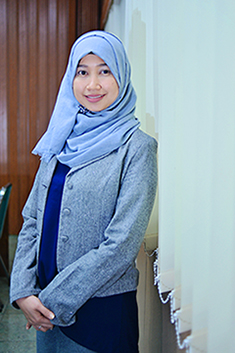Physicochemical Characteristics, Stability, and Irritability of Nanostructured Lipid Carrier System Stabilized with Different Surfactant Ratios
Downloads
Background: One of the vital variables affecting the stability and the characteristics of the Nanostructured Lipid Carrier (NLC) is the surfactant concentration. Using the two combinations of surfactants can cause higher stability and a better characteristic of NLC. Tween 80 and Span 20 are anionic surfactants whose combination has not been studied for use in NLC systems. Objective: Determine the effect of different surfactant ratios of Tween 80 and Span 20 on the physicochemical characteristics, stability, and irritability of NLC using the High Shear Homogenization (HSH) method. Methods: Four different surfactant ratios were used in the NLC formulation, in which the ratio of Tween 80:Span 20 were 5:5, 6:6, 7:7, and 8:8, respectively. In this NLC system, cetyl palmitate served as solid lipid, medium-chain triglyceride (CrodamolTM) as liquid lipid, Tween 80, and Span 20 as surfactant components. NLC was characterized for organoleptic, viscosity, pH, zeta potential, particle morphology, particle size, and polydispersity index (PDI), then evaluated for stability using the real-time and freeze-thaw method, and irritability effect. Results: The different ratios of Tween 80 and Span 20 had no significant effect on the particle size, PI, and irritation score of the NLC system. On the other hand, it influenced all formulas' pH value, viscosity, zeta potential, and stability. Conclusions: The different ratios of surfactant combination affect the characteristics and stability of the NLC system.
Agarkhed, M., O'Dell, C., Hsieh, M.-C., Zhang, J., Goldstein, J. & Srivastava, A. (2013). Effect of Polysorbate 80 Concentration on Thermal and Photostability of a Monoclonal Antibody. AAPS PharmSciTech; 14: 1–9. doi: 10.1208/s12249-012-9878-0.
Bloor, J., Morrison, J. & Rhodes, C. (1970). Effect of pH on the Micellar Properties of a Nonionic Surfactant. Journal of Pharmaceutical Sciences; 59: 387–391. doi: 10.1002/jps.2600590325.
Brito, R. S., Chandrasekhar, K. B. & Reddy, K. B. (2019). Formulation, In-Vitro and In-Vivo Pharmacokinetic Evaluation of Simvastatin Nanostructured Lipid Carrier Loaded Transdermal Drug Delivery System. Future Journal of Pharmaceutical Sciences; 5: 1-14. doi: 10.1186/s43094-019-0008-7.
Catauro, M., Tranquillo, E., Dal Pogetto, G., Pasquali, M., Dell'Era, A. & Ciprioti, S. V. (2018). Influence of the Heat Treatment on the Particles Size and on the Crystalline Phase of TiO2 Synthesized by the Sol-Gel Method. Materials; 11: 1-11. doi: 10.3390/ma11122364.
Danaei, M., Dehghankhold, M., Ataei, S., Davarani, F. H., Javanmard, R., Dokhani, A., Khorasani, S. & Mozafari, M. R. (2018). Impact of Particle Size and Polydispersity Index on the Clinical Applications of Lipidic Nanocarrier Systems. Pharmaceutics; 10: 1–17. doi: 10.3390/pharmaceutics10020057.
Dantas, M. G. B., Reis, S. A. G. B., Damasceno, C., M., S., Rolim, L. A., Rolim-Neto, P. J., Carvalho, F. O., Quintans-Junioe, L. J. & Almeida, J. R. G. S. (2016). Development and Evaluation of Stability of a Gel Formulation Containing the Monoterpene Borneol. Scientific World Journal; 2016: 1–4. doi: 10.1155/2016/7394685.
de Souza, G. L., Martinez, R. M, Bou-Chacra, N. A., Velasco, M. V. R., Rosado, C. & Baby, A. R. (2021). An Overview on Topical Administration of Carotenoids and Coenzyme q10 Loaded in lipid Nanoparticles. Antioxidants; 10: 1–25. doi: 10.3390/antiox10071034.
Durán, N., Costa, A. F., Stanisic, D., Bernardes, J. S. & Tasic, L. (2019). Nanotoxicity and Dermal Application of Nanostructured Lipid Carrier Loaded with Hesperidin from Orange Residue. Journal of Physics: Conference Series; 1323: 1-5. doi: 10.1088/1742-6596/1323/1/012021.
El Aferni, A., Guettari, M., Kamli, M., Tajour, T. & Ponton, A. (2020). A Structural Study of a Polymer-Surfactant System in Dilute and Entangled Regime: Effect of High Concentrations of Surfactant and Polymer Molecular Weight. Journal of Molecular Structure; 1199: 1-10. doi: 10.1016/j.molstruc.2019.127052.
Gokce, E. H., Korkmaz, E., Dellera, E., Sandri, G., Bonferoni, M. C. & Ozer, O. (2012). Resveratrol-Loaded Solid Lipid Nanoparticles Versus Nanostructured Lipid Carriers: Evaluation of Antioxidant Potential for Dermal Applications. International Journal of Nanomedicine; 7: 1841–1850. doi: 10.2147/IJN.S29710.
Hendradi, E., Rosita, N. & Rahmadhanniar, E. (2017). Effect of Lipid Ratio of Stearic Acid and Oleic Acid on Characteristics of Nanostructure Lipid Carrier (NLC) System of Diethylammonium Diclofenac. Indonesian Journal of Pharmacy; 28: 198–204. doi: 10.14499/indonesianjpharm28iss4pp198.
Karn-Orachai, K., Smith, S. M., Phunpee, S., Treethong, A., Puttipipatkhachorn, S., Pratontep, S. & Ruktanonchai, U. R. (2014). The Effect of surfactant Composition on the Chemical and structural Properties of Nanostructured Lipid Carriers. Journal of Microencapsulation; 31: 609–618. doi: 10.3109/02652048.2014.911374.
Kishore, R. S. K., Pappenberger, A., Dauphin, I. B., Ross, A., Buergi, B., Staempfli, A. & Mahler, H. -C. (2011). Degradation of Polysorbates 20 and 80: Studies on Thermal Autoxidation and Hydrolysis. Journal of Pharmaceutical Sciences; 100: 721–731. doi: 10.1002/jps.22290.
Kumar, A. & Dua, J. (2018). Formulation and Evaluation of Itraconazole Niosomal Gel. Asian Journal of Pharmaceutical Research and Development; 6: 76–80. doi: 10.22270/jddt.v9i4-s.3680.
Natarajan, J., Karri, V. V. S. R. & De, A. (2017). Nanostructured Lipid Carrier (NLC): A Promising Drug Delivery System. Global Journal of Nanomedicine; 1: 120–125.
Ortiz, A. C., Yañez, O., Salas-Huenuleo, E. & Morales, J. O. (2021). Development of a Nanostructured Lipid Carrier (NLC) by a low-Energy Method, Comparison of Release Kinetics and Molecular Dynamics Simulation. Pharmaceutics; 13: 1-21. doi: 10.3390/pharmaceutics13040531.
Pan, Z., Cui, B., Zeng, Z., Feng, L., Liu, G., Cui, H. & Pan, H. (2015). Lambda-Cyhalothrin Nanosuspension Prepared by the Melt Emulsification-High Pressure Homogenization Method. Journal of Nanomaterials; 2015: 1-9. doi: 10.1155/2015/123496.
Pivetta, T. P., Simíµes, S., Araújo, M. M., Carvalho, T., Arruda, C. & Marcato, P. D. (2018). Development of Nanoparticles from Natural Lipids for Topical Delivery of Thymol: Investigation of Its Anti-Inflammatory Properties. Colloids and Surfaces B: Biointerfaces; 164: 281–290. doi: 10.1016/j.colsurfb.2018.01.053.
Prakash, C., Bhargava, P., Tiwari, S., Majumdar, B. & Bhargava, R. K. (2017). Skin Surface pH in Acne Vulgaris: Insights from an Observational Study and Review of the Literature. Journal of Clinical and Aesthetic Dermatology; 10: 33–39.
Rahmasari, D. (2018). Pengaruh Kadar Surfaktan Kombinasi Tween 80 dan Span 20 terhadap Stabilitas Fisik, Iritabilitas, dan Penetrasi Resveratrol dalam Nanostructured Lipid Carrier (NLC). Surabaya: Airlangga University.
Riangjanapatee, P. & Okonogi, S. (2012). Effect of Surfactant on Lycopene-Loaded Nanostructured Lipid Carriers. Drug Discoveries & Therapeutics; 6: 163–168.
Shnoudeh, A. J., Hamad, I., Abdo, R. W., Qadumii, L., Jaber, A. Y., Surchi, H. S. & Alkelany, S. Z. (2019). Synthesis, Characterization, and Applications of Metal Nanoparticles, Biomaterials and Bionanotechnology. Advances in Pharmaceutical Product Development and Research; 2019: 527-612. doi: 10.1016/B978-0-12-814427-5.00015-9.
Shoviantari, F., Erawati, T. & Soeratri, W. (2020). Coenzyme Q10 Nanostructured Lipid Carriers as an Inducer of the Skin Fibroblast Cell and Its Irritability Test in a Mice Model. Journal of Basic and Clinical Physiology and Pharmacology; 30: 1–7. doi: 10.1515/jbcpp-2019-0320.
Suhaimi, S. H., Hasham, R. & Rosli, N. A. (2015). Effects of Formulation Parameters on Particle Size and Polydispersity Index of Orthosiphon Stamineus Loaded Nanostructured Lipid Carrier. Journal of Advanced Research in Applied Sciences and Engineering Technology; 1: 36–39.
Traul, K. A., Driedger, A., Ingle, D. L. & Nakhasi, D. (2000). Review of the Toxicologic Properties of Medium-Chain Triglycerides. Food and Chemical Toxicology; 38: 79–98. doi: 10.1016/s0278-6915(99)00106-4.
Wang, C., Cui, B., Guo, L., Wang, A., Zhao, X., Wang, Y., Sun, C., Zeng, Z., Zhi, H., Chen, H., Liu, G. & Cui, H. (2019). Fabrication and Evaluation of Lambda-Cyhalothrin Nanosuspension by One-Step Melt Emulsification Technique. Nanomaterials; 9: 1–13. doi: 10.3390/nano9020145.
Witayaudom, P. & Klinkesorn, U. (2017). Effect of Surfactant Concentration and Solidification Temperature on the Characteristics and Stability of Nanostructured Lipid Carrier (NLC) Prepared from Rambutan (Nephelium lappaceum L.) Kernel Fat. Journal of Colloid and Interface Science; 505: 1082–1092. doi: 10.1016/j.jcis.2017.07.008
Zahin, N., Anwar, R., Tewari, D., Kabir, M. T., Sajid, A., Mathew, B., Uddin, M. S., Aleya, L. & Abdel-Daim, M. M. (2020). Nanoparticles and Its Biomedical Applications in Health and Diseases: Special Focus on Drug Delivery. Environmental Science and Pollution Research; 27: 19151–19168. doi: 10.1007/s11356-019-05211-0.
Zirak, M. B. & Pezeshki, A. (2015). Effect of Surfactant Concentration on the Particle Size, Stability and Potential Zeta of Beta Carotene Nano Lipid Carrier. International Journal of Current Microbiology and Applied Sciences; 4: 924–932.
Copyright (c) 2022 JURNAL FARMASI DAN ILMU KEFARMASIAN INDONESIA

This work is licensed under a Creative Commons Attribution-NonCommercial-ShareAlike 4.0 International License.
1. The copyright of this journal belongs to the Editorial Board and Journal Manager with the author's knowledge, while the moral right of the publication belong to the author.
2. The formal legal aspect of journal publication accessibility refers to the Creative Commons Attribution-Non-Commercial-Share Alike (CC BY-NC-SA), which implies that the publication can be used for non-commercial purposes in its original form.
3. Every publication (print/electronic) is open access for educational, research, and library purposes. In addition to the objectives mentioned above, the editorial board is not responsible for copyright infringement


.jpg)















